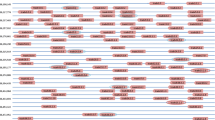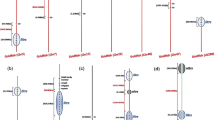Abstract
The transmembrane signaling subunits (TSSs) bearing the immunoreceptor tyrosine-based activation motif (ITAM) play a crucial role in triggering the effector functions of mammalian leukocytes. The involvement in key immune reactions and obvious extension through duplication events make TSSs valuable markers of the evolution of the immune system. We surveyed the genomic sequences of the teleostean fish Fugu rubripes for the presence of genes encoding these accessory molecules. Automatic gene prediction was not efficient because of the poor ability of the programs used to recognize the short exons encoding the intracellular regions of TSSs. However, the unique compactness of the Fugu genome and the conservation of the exon/intron arrangements of the TSS genes facilitated their recognition by visual inspection of the candidate genomic sequences. Evidence for the presence of the CD3ε, CD3γ/δ, CD79a, CD79b, TCRζ, FcRγ, DAP12 and DAP10 genes in the Fugu genome was obtained. Furthermore, conserved synteny for the short regions including the TSS genes was revealed by comparison of the Fugu and human genomes. The data demonstrate that the set of TSSs arose before the teleost–tetrapod split and provide a starting point for experimental investigation of the molecular evolution of the leukocyte-activating receptor complexes from fish species to mammals.




Similar content being viewed by others
Abbreviations
- TSS:
-
Transmembrane signal subunit
- ITAM:
-
Immunoreceptor tyrosine-based activation motif
References
Alabyev BY, Guselnikov SV, Najakshin AM, Mechetina LV, Taranin AV (2000) CD3ε homologues in the chondrostean fish Acipenser ruthenus. Immunogenetics 51:1012–1020
Aparicio S, Chapman J, Stupka E, Putnam N, Chia JM, Dehal P, Christoffels A, Rash S, Hoon S, Smit A, Gelpke MD, Roach J, Oh T, Ho IY, Wong M, Detter C, Verhoef F, Predki P, Tay A, Lucas S, Richardson P, Smith SF, Clark MS, Edwards YJ, Doggett N, Zharkikh A, Tavtigian SV, Pruss D, Barnstead M, Evans C, Baden H, Powell J, Glusman G, Rowen L, Hood L, Tan YH, Elgar G, Hawkins T, Venkatesh B, Rokhsar D, Brenner S (2002) Whole-genome shotgun assembly and analysis of the genome of Fugu rubripes. Science 297:1301–1310
Barclay AN, Brown MH, Law SKA, McKnight AJ, Tomlinson MG, van der Merwe PA (1997) The leucocyte FactsBook, 2nd edn. Academic Press, London
Bernot A, Auffray C (1991) Primary structure and ontogeny of an avian CD3 transcript. Proc Natl Acad Sci U S A 88:2550–2554
Billadeau DD, Leibson PJ (2002) ITAMs versus ITIMs: striking a balance during cell regulation. J Clin Invest 109:161–168
Burge C, Karlin S (1997) Prediction of complete gene structures in human genomic DNA. J Mol Biol 268:78–94
Campbell KS, Backstrom BT, Tiefenthaler G, Palmer E (1994) CART: a conserved antigen receptor transmembrane motif. Semin Immunol 6:393–410
Clevers HC, Dunlap S, Wileman TE, Terhorst C (1988) Human CD3-ε gene contains three miniexons and is transcribed from a non-TATA promoter. Proc Natl Acad Sci U S A 85:8156–8160
Colonna M (2003) DAP12 signaling: from immune cells to bone modeling and brain myelination. J Clin Invest 111:313–314
Daeron M (1997) Fc receptor biology. Annu Rev Immunol 15:203–234
Diefenbach A, Tomasello E, Lucas M, Jamieson AM, Hsia JK, Vivier E, Raulet DH (2002) Selective associations with signaling proteins determine stimulatory versus costimulatory activity of NKG2D. Nat Immunol 3:1142–1149
Dzialo RC, Cooper MD (1997) An amphibian CD3 homologue of the mammalian CD3 gamma and delta genes. Eur J Immunol 27:1640–1647
Fujiki K, Shin DH, Nakao M, Yano T (2000) Molecular cloning and expression analysis of carp ( Cyprinus carpio) interleukin-1 beta, high affinity immunoglobulin E Fc receptor γ subunit and serum amyloid A. Fish Shellfish Immunol 10:229–242
Gobel TW, Dangy JP (2000) Evidence for a stepwise evolution of the CD3 family. J Immunol 164:879–883
Gobel TW, Meier EL, Du Pasquier L (2000) Biochemical analysis of the Xenopus laevis TCR/CD3 complex supports the "stepwise evolution" model. Eur J Immunol 30:2775–2781
Guselnikov SV, Bell A, Najakshin AM, Robert J, Taranin AV (2003) Signaling FcRγ and TCRζ subunit homologs in the amphibian Xenopus laevis. Dev Comp Immunol 27:727–733
Hermanson GG, Eisenberg D, Kincade PW, Wall R (1988) B29: a member of the immunoglobulin gene superfamily exclusively expressed on beta-lineage cells. Proc Natl Acad Sci U S A 85:6890–6894
Howard FD, Rodewald HR, Kinet JP, Reinherz EL (1990) CD3 ζ subunit can substitute for the γ subunit of Fc ε receptor type I in assembly and functional expression of the high-affinity IgE receptor: evidence for interreceptor complementation. Proc Natl Acad Sci U S A 87:7015–7019
Hubbard T, Barker D, Birney E, Cameron G, Chen Y, Clark L, Cox T, Cuff J, Curwen V, Down T, Durbin R, Eyras E, Gilbert J, Hammond M, Huminiecki L, Kasprzyk A, Lehvaslaiho H, Lijnzaad P, Melsopp C, Mongin E, Pettett R, Pocock M, Potter S, Rust A, Schmidt E, Searle S, Slater G, Smith J, Spooner W, Stabenau A, Stalker J, Stupka E, Ureta-Vidal A, Vastrik I, Clamp M (2002) The Ensembl genome database project. Nucleic Acids Res 30:38–41
Katsukura H, Murakami R, Chijiiwa Y, Otsuka A, Tanaka M, Nakashima K, Ono M (2001) Structure of the beta-chain (B29) gene of the chicken B-cell receptor and conserved colinearity with genes for potential skeletal muscle sodium channel and growth hormone. Immunogenetics 53:770–775
Kuster H, Thompson H, Kinet JP (1990) Characterization and expression of the gene for the human Fc receptor γ subunit. Definition of a new gene family. J Biol Chem 265:6448–6452
Lanier LL, Bakker AB (2000) The ITAM-bearing transmembrane adaptor DAP12 in lymphoid and myeloid cell function. Immunol Today 21:611–614
Lanier LL, Yu G, Phillips JH (1989) Co-association of CD3ζ with a receptor (CD16) for IgG Fc on human natural killer cells. Nature 342:803–805
Lennon G, Auffray C, Polymeropoulos M, Soares MB (1996) The I.M.A.G.E. Consortium: an integrated molecular analysis of genomes and their expression. Genomics 33:151–152
Litman GW, Rast JP (1996) The organization and structure of immunoglobulin and T-cell receptor genes in the most phylogenetically distant jawed vertebrates: evolutionary implications. Res Immunol 147:226–233
Malissen B, Ardouin L, Lin SY, Gillet A, Malissen M (1999) Function of the CD3 subunits of the pre-TCR and TCR complexes during T cell development. Adv Immunol 72:103–148
Matsuuchi L, Gold MR (2001) New views of BCR structure and organization. Curr Opin Immunol 13:270–277
Milanesi L, D'Angelo D, Rogozin IB (1999) GeneBuilder: interactive in silico prediction of gene structure. Bioinformatics 15:612–621
Moretta A, Bottino C, Vitale M, Pende D, Cantoni C, Mingari MC, Biassoni R, Moretta L (2001) Activating receptors and coreceptors involved in human natural killer cell-mediated cytolysis. Annu Rev Immunol 19:197–223
Morton HC, Van den Herik-Oudijk IE, Vossebeld P, Snijders A, Verhoeven AJ, Capel PJA, Van de Winkel JGJ (1995) Functional association between the human myeloid immunoglobulin A Fc receptor (CD89) and FcRγ chain. J Biol Chem 270:29781–29787
Nakajima H, Samaridis J, Angman L, Colonna M (1999) Human myeloid cells express an activating ILT receptor (ILT1) that associates with Fc receptor γ-chain. J Immunol 162:5–8
Niiro H, Clark EA (2002) Regulation of B-cell fate by antigen-receptor signals. Nat Rev Immunol 2:945–956
Park CI, Hirono I, Enomoto J, Nam BH, Aoki T (2001) Cloning of Japanese flounder Paralichthys olivaceus CD3 cDNA and gene, and analysis of its expression. Immunogenetics 53:130–135
Pozios KC, Ding J, Degger B, Upton Z, Duan C (2001) IGFs stimulate zebrafish cell proliferation by activating MAP kinase and PI3-kinase-signaling pathways. Am J Physiol Regul Integr Comp Physiol 280:1230–1239
Qian D, Sperling AI, Lancki DW, Tatsumi Y, Barrett TA, Bluestone JA, Fitch FW (1993) The γ chain of the high-affinity receptor for IgE is a major functional subunit of the T-cell antigen receptor complex in γδ T lymphocytes. Proc Natl Acad Sci U S A 90:11875–11879
Ravetch JV, Kinet JP (1991) Fc receptors. Annu Rev Immunol 9:457–492
Sada K, Takano T, Yanagi S, Yamamura H (2001) Structure and function of Syk protein-tyrosine kinase. J Biochem 130:177–186
Sayegh CE, Demaries SL, Pike KA, Friedman JE, Ratcliffe MJ (2000) The chicken B-cell receptor complex and its role in avian B-cell development. Immunol Rev 175:187–200
Shores EW, Ono M, Kawabe T, Sommers CL, Tran T, Lui K, Udey MC, Ravetch J, Love PE (1998) T cell development in mice lacking all T cell receptor zeta family members (ζ, η, FcεRIγ). J Exp Med 187:1093–1101
Steele RE, Stover NA, Sakaguchi M (1999) Appearance and disappearance of Syk family protein-tyrosine kinase genes during metazoan evolution. Gene 239:91–97
Takai T, Li M, Sylvestre D, Clynes R, Ravetch JV (1994) FcRγ chain deletion results in pleiotropic effector cell defects. Cell 76:519–529
Terhorst C, Simpson S, Wang B, She J, Hall C, Huang M, Wileman N, Eichmann K, Holländer G, Levelt C, Exley M (1995) Plasticity of the TCR-CD3 complex. In: Bell JI, Owen MJ, Simpson E (eds) T cell receptors. Oxford University Press, Oxford, p 369
Thanaraj TA, Robinson AJ (2000) Prediction of exact boundaries of exons. Brief Bioinform 1:343–356
Tsuji M, Ezumi Y, Arai M, Takayama H (1997) A novel association of Fc receptor γ-chain with glycoprotein VI and their co-expression as a collagen receptor in human platelets. J Biol Chem 272:23528–23531
Tunnacliffe A, Olsson C, Buluwela L, Rabbitts TH (1988) Organization of the human CD3 locus on chromosome 11. Eur J Immunol 18:1639–1642
van den Elsen P, Georgopoulos K, Shepley BA, Orkin S, Terhorst C (1986) Exon/intron organization of the genes coding for the delta chains of the human and murine T-cell receptor/T3 complex. Proc Natl Acad Sci U S A 83:2944–2948
von Essen M, Menne C, Nielsen BL, Lauritsen JP, Dietrich J, Andersen PS, Karjalainen K, Odum N, Geisler C (2002) The CD3γ leucine-based receptor-sorting motif is required for efficient ligand-mediated TCR down-regulation. J Immunol 168:4519–4523
Wilson MJ, Lindquist JA, Trowsdale J (2000) DAP12 and KAP10 (DAP10)-novel transmembrane adapter proteins of the CD3ζ family. Immunol Res 22:21–42
Wu J, Song Y, Bakker AB, Bauer S, Spies T, Lanier LL, Phillips JH (1999) An activating immunoreceptor complex formed by NKG2D and DAP10. Science 285:730–732
Zompi S, Hamerman JA, Ogasawara K, Schweighoffer E, Tybulewicz VL, Di Santo JP, Lanier LL, Colucci F (2003) NKG2D triggers cytotoxicity in mouse NK cells lacking DAP12 or Syk family kinases. Nat Immunol 4:565–572
Acknowledgements
This work was supported in part by Russian Foundation for Basic Research grant 02-04-49882. The authors are grateful to Mrs. A. Fadeeva for help in preparation of the manuscript.
Author information
Authors and Affiliations
Corresponding author
Rights and permissions
About this article
Cite this article
Guselnikov, S.V., Najakshin, A.M. & Taranin, A.V. Fugu rubripes possesses genes for the entire set of the ITAM-bearing transmembrane signal subunits. Immunogenetics 55, 472–479 (2003). https://doi.org/10.1007/s00251-003-0599-0
Received:
Revised:
Published:
Issue Date:
DOI: https://doi.org/10.1007/s00251-003-0599-0




